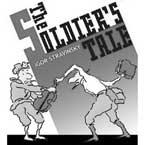
Expect good things when the San Francisco Conservatory of Music teams up with the American Conservatory Theater for a new production of The Soldier’s Tale. With two performances scheduled for Nov. 14 in the Conservatory’s Sol H. Joseph Recital Hall, the fully staged production, directed by Giles Havergal and conducted by Nicole Paiement, is a must-see for Stravinsky aficionados and first-timers alike.
L’Histoire was in some ways a work of necessity: Stravinsky, collaborating with novelist and librettist C.F. Ramuz, wrote the score in Switzerland while the Great War raged throughout Europe. Money was scarce, so the collaborators planned the work as a simple production that could be moved from town to town. Stravinsky scored the work for septet, with each orchestral section represented by one treble and one bass instrument. The work was designed “to be read, played, and danced.” Its jazz influences are everywhere in evidence, and the work as a whole represents a decided shift in Stravinsky’s musical direction. “L’Histoire,” said the composer, “marks my final break with the Russian Orchestral School.” The premiere, in Lausanne on Sept. 28, 1918, was a success, albeit a short-lived one; the next day, the theaters closed due to an outbreak of Spanish influenza. L’Histoire was not performed again until 1924. /l’histoire>
The work continued to fuel the imaginations of artists throughout the 20th century: novelist Kurt Vonnegut, jazz musician Wynton Marsalis, animator R.O. Blechman, and choreographer Peter Martins all adapted L’Histoire in various guises.
The new production, presented as part of the Conservatory’s BluePrint New Music series, will feature a septet of mixed winds, strings, and percussion. Actors from the American Conservatory Theater’s master of fine arts program will play the Soldier, the Devil, and the Narrator, and a dancer to be announced will assume the nonspeaking role of the Princess. Havergal, an A.C.T. associate artist, directs, while Paiement, artistic director of the Conservatory’s New Music Ensemble, conducts.
According to Paiement, the production will give audiences the opportunity to experience The Soldier’s Tale as Stravinsky might have envisioned it, while affording the young performers valuable interdisciplinary experience. “This will be a stimulating challenge for everyone, because the staging will have the musicians, the actors, and dancer interacting together onstage, unlike opera or musical theater, where the musicians are isolated in an orchestra pit,” said the conductor. “For us, this is a long-dreamt-of opportunity to collaborate with actors and dancers in the creation of theater works other than opera.”

